
(A nice improvement over the previous exam!)
1. __________
2. __________
3. __________
4. __________
CQ ________
Total __________

(A nice improvement over the previous exam!)
Again, pace yourself . Don’t spend too
much time on one problem. Write what you know and go on to another
problem. If you have time, you can come back and think more about a
problem. I can’t give partial credit for a blank page.
1. In the Bohr model of the hydrogen atom, an electron in the
lowest energy state follows a circular path, 5.29 x 10 -
11 m from the proton.
(a) Show that the speed of the electron is 2.19 x 106
m/s.
What holds the electron in its orbit?
The centripetal force is supplied by the electric
force from Coulomb's Law
(b) What is the effective current associated with this orbiting
electron?
Current is given by
What is the period of this electron in orbit?
That is, an electron, with Q = e = 1.6 x 10 -
19 C of charge passes by every 1.2 x 10 - 16 s for a
current of
2. Calculate the resistance at
20oC of a 40-m, length of silver wire having a
cross-sectional area of 0.40 mm2.
The resistivity of silver is 1.59 x 10 - 8 ![]() -m
-m
Reminder:
Conversion from mm to m seems to be easy but this conversion from mm2 to m2 caused more confusion than I think it should have. Since the mm in the area is squared the conversion fractor from mm2 to m2 must also be squared.
Don't forget to square the conversion factor in cases like this -- in area conversions.
3. Find the equivalent resistance in the
circuit shown below for R1 = 100 ![]() ,
R2 = 500
,
R2 = 500 ![]() ,
R3 = 1000
,
R3 = 1000 ![]() ,
R4 = 400
,
R4 = 400 ![]() .
If these are connected to a 12&endash;volt battery, what is the power
supplied by the battery? Find the current through resistor
R1 and the power supplied to R1.
.
If these are connected to a 12&endash;volt battery, what is the power
supplied by the battery? Find the current through resistor
R1 and the power supplied to R1.
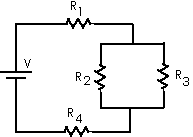
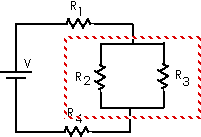
Resistors R2 and R3 are in
parallel so we will replace them with a single equivalent resistor,
Req1;
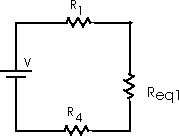
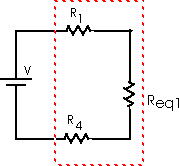
Now the three resistors, R1,
Req1, and R4 are in series, so we replace them
with a single equivalent resistor Req.
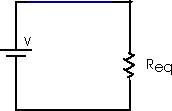
How much power does the battery supply?
P = V2 / R
P = (12 V)2 / 833 ![]()
P = 0.173 W
Remember this is the total power supplied by the battery.
How much current flows out of the
battery?
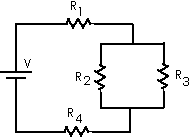
The current that flows out of the battery is the
same as the current that flows through resistor R1 (and
R4).
What is the power absorbed by
R1?
Note or caution:
If you decided to use P = I V, be sure that you use the voltage across resistor R1. And that voltage is not 12 V! However, if you did not realize that and went ahead and -- somehow -- did use 12 volts, look at what happens!
P = (0.014 4 A)(12 V)
P = 0.173 W
And that is the same as the total power supplied by the battery!.
Or, if you decided to use P = V2/R, be sure hat you use the voltage across resistor R1. And that voltage is not 12 V! However, if you did not realize that and went ahead and -- somehow -- did use 12 volts, look at what happens!
P = (12 V)2/100
![]()
P = 1.44 W
and that is more -- considerably more! -- power than the total power supplied by the battery! Always ask if an answer is "reasonable", or "plausible" -- or possible! Always!
4. Consider the following RC circuit with R
= 2 M![]() and C =
5 mf and Vbat = 12 volts. Initially, the capacitor is
uncharged. The switch is closed at time t = 0.
and C =
5 mf and Vbat = 12 volts. Initially, the capacitor is
uncharged. The switch is closed at time t = 0.
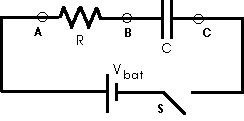
(a) What is the initial current immediately after
the switch is closed?
(b) If we wait a very long time, what is the final charge that
eventually collects on the capacitor?
(c) What is the “time constant” of this RC circuit?
(d) How much charge will there be on the capacitor 5 seconds after
the switch is closed?
&emdash;&emdash;&emdash;&emdash;&emdash;&emdash;&emdash;&emdash;&emdash;&emdash;&emdash;&emdash;&emdash;&emdash;&emdash;&emdash;&emdash;&emdash;&emdash;&emdash;&emdash;&emdash;&emdash;&emdash;&emdash;&emdash;&emdash;&emdash;
(a) I o = V/R = 12 V / 2 x 106 W = 6 x 10
- 6 A
(b) C = Q/V; Qf = CV = (5 x10 - 6 f) (12 V) =
60 x 10 - 6 C = 60 mC
(c) t = RC = (2 x 106 W)(5 x1 0 - 6 f) = 10
s
(d) q = q(t) = Qf e - t/t = [60 mC]
e - 5s/10s = [60 mC] e - 0.5
q(5s) = [60 mC][0.3935] = 23.6 mC
Conceptual Questions:
1. Two lightbulbs both operate from 110 V, but one has a power
rating of 25 W and the other, of 100 W. Which bulb carries the
greater current?
Use P = I V or I = P / V
For the same voltage (110 V), the current is proportional to the
power. So the 100 W bulb carries four times the current of the 25 W
bulb.
Q2. How would you connect resistors so that the equivalent
resistance is smaller than the individual resistance?
Resistors in paralled will provide an equivalent resistance
that is smaller than the smallest individual resistance.
Q3. At a given instant, a proton moves in the positive x
cirection in a region where there is a magnetic field in the negative
z direction. What is the direction of the magnetic force? Does the
proton continue to move in the positive x direction?
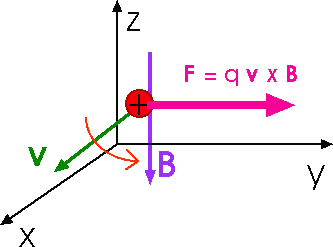
The vector v x B points along the
positive y-direction. For a proton, q is positive, so the Force
vector F = q v x B also points along the positive y-direction. With a
force on it in the positive y-direction, the proton will be moved
from its initial path. The proton will move in a circle in a plane
parallel to the xy-plane.
Q4. Explain why two parallel wires carrying
currents in the same direction attract each other.

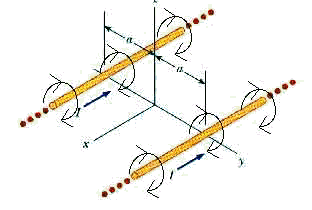
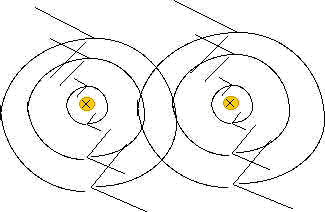
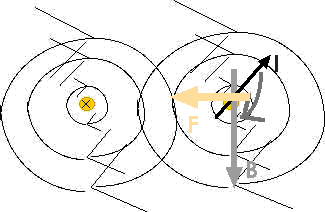
Look at the magnetic field caused by the left current. At the location of the right current, B points down. The current in the conductor on the right is pointing into the page (or the screen) so the magnetic force F is to the left, toward the other current-carrying conductor. By Newton’s Third Law, the force on the left current will be just the opposite. These are forces of attraction.